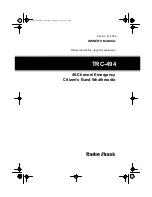
Operation
General Specifications
13
14
Frequency Allocation and Compatibility
A = Channel No. for 22 Channel Models
B = Frequency in MHz
C = Power Output
A B C
1
462.5625
High
2
462.5875
High
3
462.6125
High
4
462.6375
High
5
462.6625
High
6
462.6875
High
7
462.7125
High
8
467.5625
Low
9
467.5875
Low
10 467.6125 Low
11
467.6375
Low
12
467.6625
Low
13
467.6875
Low
14
467.7125
Low
15
462.5500
High
16
462.5750
High
17
462.6000
High
18
462.6250
High
19
462.6500
High
20
462.6750
High
21
462.7000
High
22
462.7250
High
IMPORTANT NOTICE:
WARNING:
Changes or modifications to this unit not expressly approved by the party responsible
for compliance could void the user’s authority to operate the equipment.
This device complies with Part 15 of the FCC Rules. Operation is subject to the following two
conditions: 1) This device may not cause harmful interference, and 2) this device must accept any
interference received,including interference that may cause undesired operation.
NOTE:
This equipment has been tested and found to comply with the limits for a Class B digital
device, pursuant to Part 15 of the FCC Rules. These limits are designed to provide reasonable
protection against harmful interference in a residential installation. This equipment generates, uses
and can radiate radio frequency energy and, if not installed and used in accordance with the
instructions, may cause harmful interference to radio communications.
However, there is no guarantee that interference will not occur in a particular installation. If this
equipment does cause harmful interference to radio or television reception, which can be
determined by turning the equipment off and on, the user is encouraged to try to correct the
interference by one or more of the following measures:
• Reorient or relocate the receiving antenna.
• Increase the separation between the equipment and receiver.
• Connect the equipment into an outlet on a circuit different from that to which the receiver is
connected.
• Consult the dealer or an experienced radio/TV technician for help.
Safety Information for Radios
Your wireless handheld portable transceiver contains a low power transmitter. When the talk button
is pushed, it sends out radio frequency (RF) signals. The device is authorized to operate at a duty
factor not to exceed 50%. In August 1996, the Federal Communications Commissions (FCC) adopted
RF exposure guidelines with safety levels for handheld wireless devices
Important
FCC/ISEDC RF Exposure Requirements: For body-worn operation, this radio has been tested and meets
the FCC/ISEDC RF exposure guidelines when used with D
E
WALT accessories supplied or designated for
this product. Use of other accessories may not ensure compliance with FCC/ISEDC RF exposure guidelines.
Use only the supplied antenna. Unauthorized antennas, modifcations or attachments could damage the
transmitter and may violate FCC/ISEDC regulations.
Normal Position
Hold the transmitter approximately 25 mm from your face and speak in a normal voice, with the
antenna pointed up and away.
ISEDC WARNING
This device complies with ISEDC license-exempt RSS standard(s). Operation is subject to the
following two conditions: (1) this device may not cause interference, and (2) this device must accept
any interference, including interference that may cause undesired operation of the device.
Under ISEDC regulations, this radio transmitter may only operate using an antenna of a type and
maximum (or lesser) gain approved for the transmitter by ISEDC. To reduce potential radio
interference to other users, the antenna type and its gain should be so chosen that the equivalent
isotropically radiated power (e.i.r.p.) is not more than that necessary for successful communication.
The applicant is responsible for providing proper instructions to the user of the radio device, and any
usage restrictions, including limits of exposure durations. The user manual shall provide installation
and operation instructions, as well as any special usage conditions, to ensure compliance with SAR
and/or RF field strength limits. For instance, compliance distance shall be clearly stated in the user
manual.
Cet
appareil
est
conforme
aux
normes
RSS
exemptes
de
licence
ISEDC.
Son
fonctionnement
est
soumis
aux
deux
conditions
suivantes:
(1)
cet
appareil
ne
doit
pas
provoquer
d'interférences
et
(2)
cet
appareil
doit
accepter
toute
interférence,
y
compris
les
interférences
pouvant
entraîner
un
fonctionnement
indésirable
de
l'appareil.
En
vertu
des
réglementations
ISEDC,
cet
émetteur
radio
ne
peut
fonctionner
qu'avec
une
antenne
d'un
type
et
un
gain
maximal
(ou
inférieur)
approuvé
pour
l'émetteur
par
l'ISEDC.
Pour
r
é
duire
les
interférences
radio
potentielles
avec
d’autres
utilisateurs,
le
type
d’antenne
et
son
gain
doivent
être
choisis
de
manière
à
ce
que
la
puissance
isotrope
rayonnée
équivalente
(e.i.r.p.)
ne
soit
pas
supérieure
à
celle
nécessaire
à
une
communication
réussie.
Le
demandeur
est
responsable
de
fournir
des
instructions
appropriées
à
l'utilisateur
du
dispositif
radio
et
de
toute
restriction
d'utilisation,
y
compris
les
limites
de
la
durée
d'exposition.
Le
manuel
de
l'utilisateur
doit
fournir
des
instructions
d'installation
et
d'utilisation,
ainsi
que
des
conditions
d'utilisation
spéciales,
pour
assurer
la
conformité
avec
les
limites
de
champ
de
SAR
et
/
ou
RF.
Par
exemple,
la
distance
de
conformité
doit
être
clairement
indiquée
dans
le
manuel
d'utilisation.
Important:
Exigences de la FCC/ISEDC concernant l’exposition aux champs électro-magnétiques RF (radiofréquences):
En ce qui concerne le fonctionnement de l’appareil porté sur le corps de l’utilisateur, les tests effectués ont
permis de vérifier que cet émetteur-récepteur satisfait aux directives FCC/ISEDC limitant l’exposition aux champs
électro-magnétiques RF lorsqu’il est utilisé avec les accessoires Cobra fournis ou conçus pour ce produit;
l’utilisation d’autres accessoires peut ne pas garantir le respect des critères des directives FCC/ISEDC limitant
l’exposition aux champs électro-magnétiques RF. Utiliser l’appareil uniquement avec l’antenne fournie.
L’emploi d’une antenne non homologuée ou modifiée, ou d’accessoires non autorisés, pourrait faire subir
des dommages à l’appareil, et peut violer les prescriptions de la réglementation FCC/ISEDC.
Position normale:
Tenir l'émetteur à environ 25 mm de la bouche et parler normalement, l'antenne étant éloignée et
dirigée vers le haut.
Содержание DXFRS300
Страница 12: ...Notes 17 18 ...






























